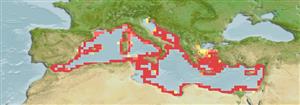Common names from other countries
Elasmobranchii (tubarões e raias) (sharks and rays) >
Myliobatiformes (Stingrays) >
Dasyatidae (Stingrays) > Dasyatinae
Etymology: Dasyatis: Greek, dasys = rough, dense (Ref. 45335).
Environment: milieu / climate zone / depth range / distribution range
Ecologia
marinhas demersal; intervalo de profundidade 100 - 200 m (Ref. 51024). Temperate; 46°N - 30°N, 6°W - 36°E
Northeast Atlantic: known only from the Mediterranean. Validity of this species questioned in Compagno's 1999 checklist (Ref. 35766).
Tamanho / Peso / Idade
Maturity: Lm ? range ? - ? cm
Max length : 80.0 cm WD macho/indeterminado; (Ref. 3169); common length : 65.0 cm WD macho/indeterminado; (Ref. 3169)
Found over sandy and muddy bottoms. Feeds on bottom-living invertebrates and fishes. Ovoviviparous, gestation about 4 months and about 6 to 9 young are produced.
Life cycle and mating behavior
Maturities | Reprodução | Spawnings | Egg(s) | Fecundities | Larvas
Exhibit ovoviparity (aplacental viviparity), with embryos feeding initially on yolk, then receiving additional nourishment from the mother by indirect absorption of uterine fluid enriched with mucus, fat or protein through specialised structures (Ref. 50449). Distinct pairing with embrace (Ref. 205).
McEachran, J.D. and C. Capapé, 1984. Dasyatidae. p. 197-202. In P.J.P. Whitehead, M.-L. Bauchot, J.-C. Hureau, J. Nielsen and E. Tortonese (eds.) Fishes of the north-eastern Atlantic and Mediterranean. UNESCO, Paris. Vol. 1. (Ref. 3169)
Categoria na Lista Vermelha da IUCN (Ref. 130435)
CITES (Ref. 128078)
Not Evaluated
Ameaça para o homem
Harmless
Utilização humana
Ferramentas
Relatórios especiais
Descarregue XML
Fontes da internet
Estimates based on models
Preferred temperature (Ref.
115969): 13.3 - 16.1, mean 14.9 (based on 33 cells).
Phylogenetic diversity index (Ref.
82804): PD
50 = 0.5002 [Uniqueness, from 0.5 = low to 2.0 = high].
Bayesian length-weight: a=0.00646 (0.00265 - 0.01571), b=3.06 (2.86 - 3.26), in cm Total Length, based on LWR estimates for this (Sub)family-body shape (Ref.
93245).
Nível Trófico (Ref.
69278): 4.0 ±0.62 se; based on food items.
Resiliência (Ref.
120179): Muito baixo, tempo mínimo de duplicação da população maior que 14 anos (Fec=6-9).
Fishing Vulnerability (Ref.
59153): Very high vulnerability (78 of 100).
